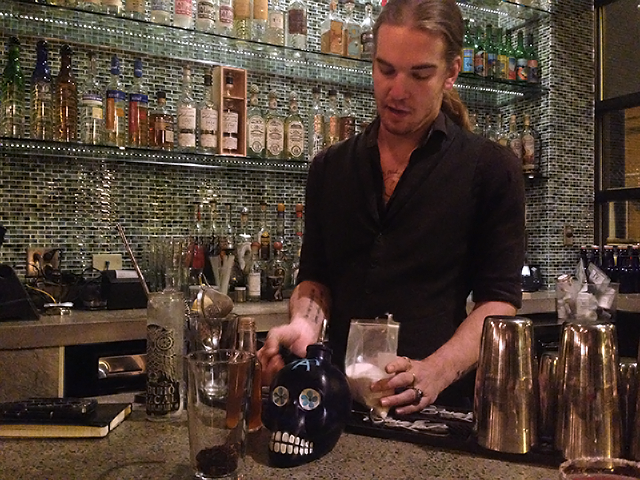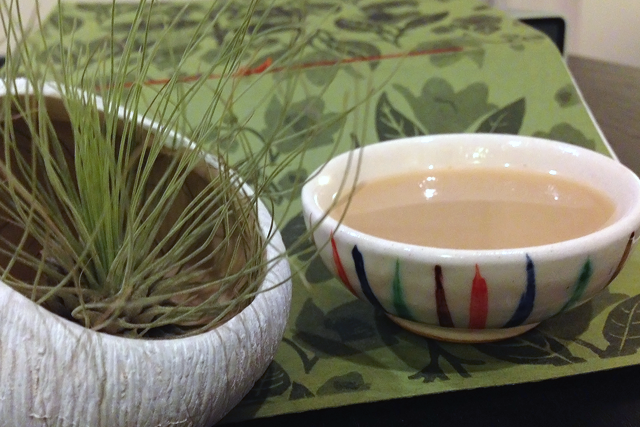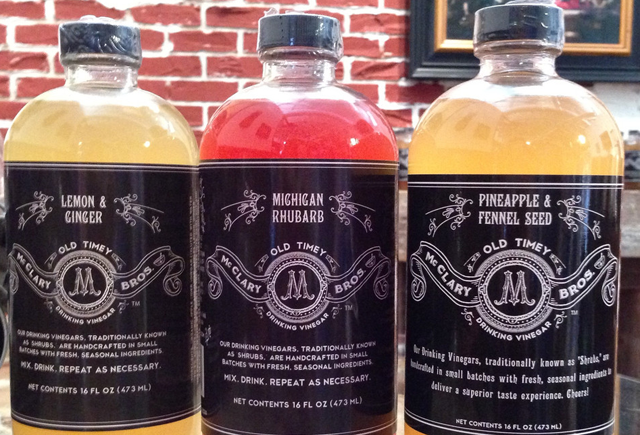Sour Power: Beyond Lemon And Limes In Cocktails
By Melissa McEwen in Food on Jan 15, 2015 5:30PM
It’s hard to find a cocktail bar that doesn’t have a huge bowl of lemons and limes, but not Brian Adee’s bar at Masa Azul (2901 W. Diversey Ave.). He finds working without the ubiquitous ingredients to be a welcome challenge that opens up a word of other opportunities for adding tangy tastes to drinks.
The main acid in lemons and limes is citric acid, but it’s only one of many acids found in food with their own distinct sourness. A recent fiasco at the Festival of Barrel and Wood-Aged Beers highlighted that not everyone in beverages know them all that well. The conflict there stemmed from the inability to distinguish between a beer made with Lactobacillus, which is mostly flavored with—no surprise—lactic acid, and a beer made with the Brettanomyces yeast, which produces mainly acetic acid. Lactic acid is found in dairy ferments like yogurt and sour cream, as well as pickles. You are probably familiar with acetic acid because it’s the main acid in vinegar as well as the dominant acid in the fermented tea drink known as kombucha.
You can occasionally find acetic acid in cocktails, especially now that shrubs are growing in popularity, which typically are vinegar-based. Devin Kidner of Hollow Leg, who teaches cocktail and cooking classes, started to use vinegars in her cocktails because she wanted to challenge herself to create drinks using 100% local ingredients.
Kidner makes her own vinegar, which she confessed started by accident “I bought some Seedling cider and left it in the fridge and forgot about it. When I finally noticed it is had gotten bloated, I left the air out, then I noticed it got fizzy and a film formed on the top. I almost threw it out, not realizing I had mother of vinegar.” Mother of vinegar is a colony of acetic-acid producing yeast that forms on actively fermenting vinegars. “I tasted it and it was a lovely apple cider vinegar, so I decided to try to make other vinegars to use in drinks.” She just uses small amounts in cocktails to add complexity and sourness- about ⅛ of a teaspoon. One of her favorites so far is mimosas with a bit of vinegar and cranberries instead of orange juice. “People are surprised to learn it’s vinegar because it is so mild.”
Then there are the trendy shrubs, which take vinegar and add fruits (and sometimes vegetables) and sugar to create a versatile ingredient that tastes delicious as a refreshing tonic with soda water or in cocktails. Michael Dietsch’s book Shrubs contains a wealth of recipes as well as a comprehensive history on the subject. If you don't want to make your own there are a variety of shrubs now on the market, some called "drinking vinegar" like the ones offered by Michigan-based McClary Bros. . I picked up some of their Michigan Beet & Carrot to make gin cocktails with at Green Grocer.
For the holidays I made a cranberry shrub with apple cider vinegar as well as the gorgeously green celery shrub, which the book says is reminiscent of Jewish deli cult favorite Cel-Ray soda.
Celery Shrub Recipe
Reprinted with permission from Shrubs
1 pound celery
1 cup sugar
1 cup apple cider vinegar
1. Wash celery stalks and, if necessary, shrub with a vegetable brush to remove dirt
2. Cut the stalks into 1 inch pieces
3. Add celery to blender and cover with about ½ cup water
4. Start the blender on low, and as the celery starts to get chopped up, turn the speed up to puree. If, after about 30 seconds, the mixture is still very thick and chunky, add a little more water.
5. Place a fine-mesh strainer over a bowl. Line with a piece of cheesecloth if desired. Pour the celery mixture through the strainer. press or squeeze the celery puree to express the juice into the bowl.
6. Pour celery juice into a jar. Add sugar and cider vinegar. Cap the jar and shake to combine.
7. Refrigerate, shaking well every other day or so to dissolve sugar.
Cook’s notes: I juiced the celery with my juicer, which eliminated steps 2-5. And I used white wine vinegar because I didn’t want any apple flavor.

CellRaiser
A weirdly refreshing drink I made when I was craving Cel-Rey soda. It contains other elements of Jewish culinary traditions- the caraway found in classic rye bread and plum brandy AKA Slivovitz.
2 oz. celery shrub
1 oz. plum brandy (I used Rhine Hall’s great new version)
A splash of caraway bitters or other savory bitters
A pinch of salt
Shake with ice, top with sparkling water/seltzer to taste.
Caraway Bitters
1 tablespoon caraway
½ cup high-proof vodka
Put the caraway and vodka in a jar for two weeks, shake daily. Then filter (I use a coffee filter) and store in a jar. If you want a heavier caraway flavor, take the caraway seeds filtered out, cover with water and simmer for 10 minutes, then add this back into the vodka and let sit for a week and then try again.
But the cranberry shrub I made was too pungent to use in most cocktails, probably because the apple cider vinegar I used was so strong.
It’s a problem Kidner is familiar is “Apple cider becomes sharp and pungent, there’s no mellowness and you just taste vinegar. Now that I’m on a vinegar kick I want to make wine vinegars and I’m experimenting a bit with Illinois sparkling wines.”
That’s one reason Adee prefers mainly purified fruit acids: citric, malic, and tartaric are all behind the bar. He says that using them as isolates allows him to lend a clean controlled tartness that’s flexible for many styles of drinks and avoids the vinegary taste that some people find unpleasant.

Brian Adee with his acid blend
Malic acid is named after apples and is responsible for tartness in that fruit, tartaric acid is the primary acid in wine, though wine often contains all three of these acids often called vintner’s acid blend. He uses them to make two major cocktail elements: cordials and agrumes. A cordial provides both sweet and sour to drinks. The use of refined acids allows the preservation of the sweeteners main flavors. A simple maple cordial for example is made with maple syrup and an acid. Adee also instructs his readers on steeped cordials, which allow you to turn any water-soluble ingredient like tea into a sweet-sour cocktail ingredient.
Agrumes, an ingredient of Adee’s own naming, are another method of doing this. Agrumé is French for “acid water.” Unlike cordials, they do not contain the sweet element.
“It allows for hundreds of thousands of opportunities not hemmed in by the flavors of lemon and lime” says Adee “you can use any water-soluble ingredient. It’s a lot of fun stepping outside the typical sour flavors and build truly new drinks.” These include hibiscus cordials, which are a beautifully bright pink-purple color. And agrumés made with teas like the earthy smoky Lapsang Souchong.
And unlike many modernist takes on cocktails, Brian's recipes are extremely easy for anyone to do at home, especially now that it’s pretty easy to find acids like citric at spice and homebrew shops. You can find many of Adee’s recipes and thoughts on cocktails on his excellent blog, Chemically Assisted.
I make a green tea agrumé with Brian's base recipe and used it in Ella Megalast Burls Forever, a delicious creamy tiki-like drink with Parce Rum 8-year:

Pistachio Orgeat
Recipe by Nick Hruza
1 cup raw pistachios
2-3g lavender
1-2 g Tellicherry Peppercorns (compared to other black pepper tellicherries have more of a floral note that compliments the other flavors)
~8g Rose Water (to taste)
4 cups boiling water
240g sugar (see note in step 7)
1. Soak nuts overnight (softens and makes a smoother end result)
2. Drain nuts.
3. Boil 4 cups of water
4. Add lavender and black pepper for flavor to the boiling water and let steep for few min until it comes off the boil a bit.
5. Add add nuts and water(with aromatics) to a blender and blend until very smooth.(I let it sit for maybe 5 min more to let everything infuse a bit more)
6. Strain with a fine sieve.
7. Add sugar based on your yield. 2:1 Nut Milk to sugar by weight. (Assuming 480g of nut milk add 240g sugar). Should be still warm enough dissolve sugar.
8. Add rose water to taste
9. I added a few tbsp of the soaking liquid back. I like the idea of incorporating a bit of the original salt back in to enhance the flavor a bit.
Ella Megalast Burls Forever
2 parts rum
2 parts Pistachio Orgeat
1 part green tea agrumé (base recipe here)
4 dashes Angostura bitters or Bittercube Jamaican #1
Shake and double-strain into a coupe.


